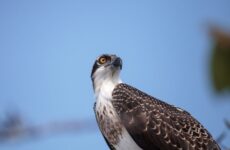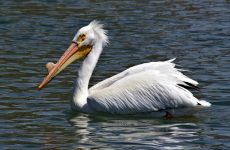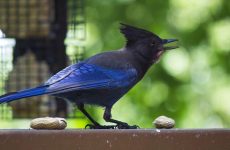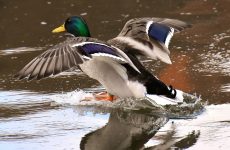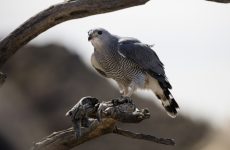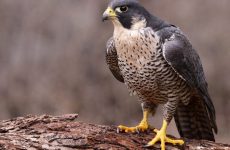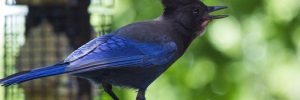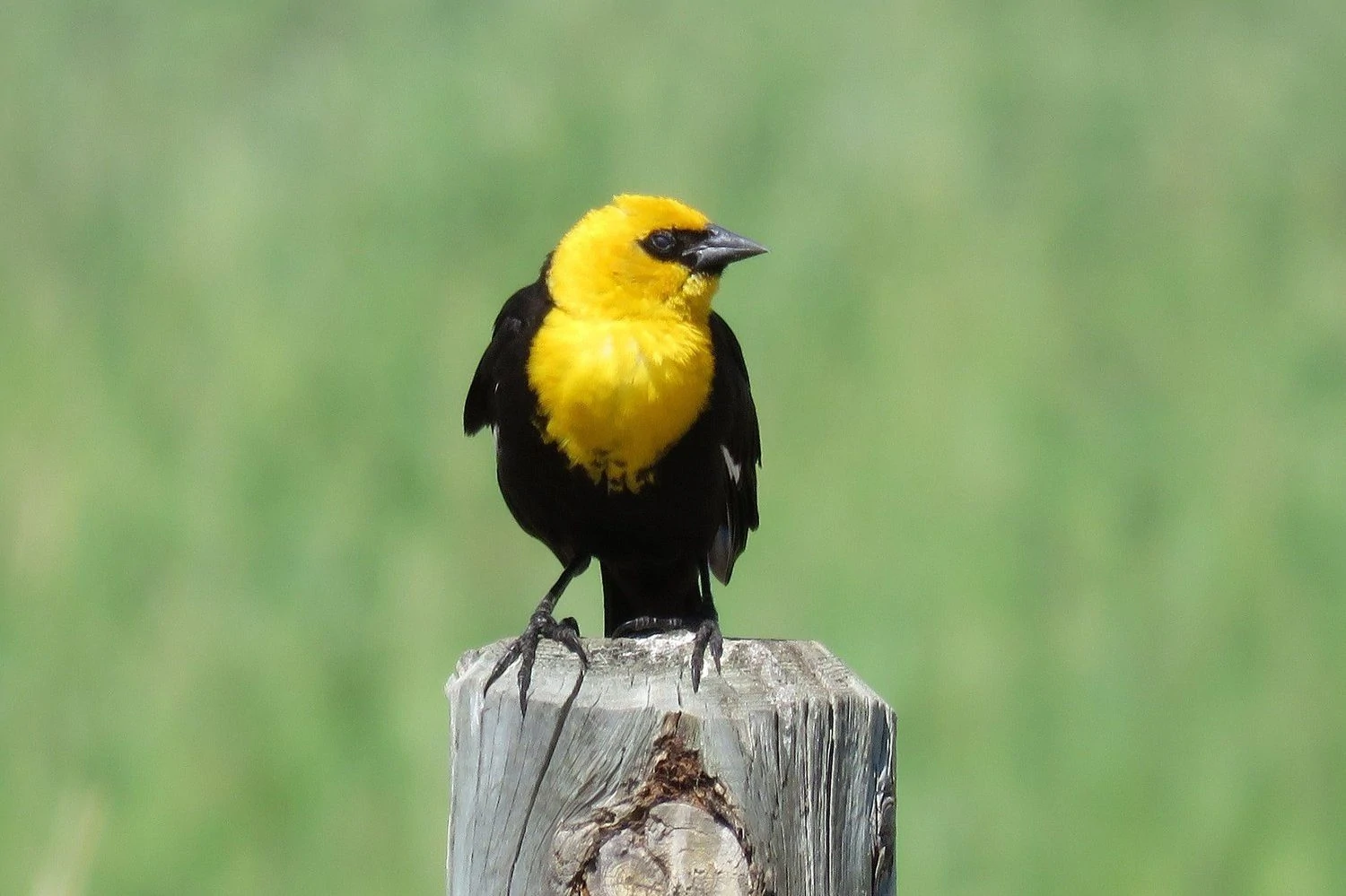
Although named “blackbirds,” they are, in fact, often brightly colored and are all the Icteridae family, which are common songbirds. They are classed as New World Blackbirds in North America to distinguish them from European Blackbirds which are part of the thrush family.
There are 25 species of New World Blackbirds spotted in North America, and 17 of these are spotted in Oklahoma, including Blackbirds, Orioles, Meadowlarks, Cowbirds, Grackles, and Bobolinks.
Of the seventeen species of blackbirds in Oklahoma, fifteen species are recognized on state checklists as regularly occurring, two species are considered rare or accidental, and three of these are also regarded as near-threatened or vulnerable.
Whether you consider them noisy pests or intelligent and bright acrobats, there is no doubt that blackbirds are fascinating birds.
Due to their ability to devour vast quantities of seeds and grains, Blackbirds are considered an agricultural pest. In fact, Bobolinks have decreased by up to 60% in the last 50 years, in part due to persecution and declining habitat.
Male and female blackbirds can vary greatly in size and color, with males being up to 60% heavier than females and some having much brighter coloration.
Nests are a fascinating subject when it comes to blackbirds as some don’t build them at all, like cowbirds, which instead lay their eggs in other species’ nests for the host family to raise their young. Some orioles, on the other hand, build elaborate hanging nests.
Blackbirds can strongly force their bills open to allow them to prize open gaps to get to hidden food, but most birds cannot do this.
Many blackbirds migrate, especially from more northern areas, so check out the end of the article to see how common each blackbird is in summer or winter to help you know when to look for them.
This guide will help you identify the species of blackbirds spotted in Oklahoma, according to avibase. The birds in this list are ordered by how frequently they are spotted in the state, from most frequent to least frequent, according to bird watchers’ checklists for the state submitted to ebird.
17 Species of Blackbirds in Oklahoma
1. European Starling
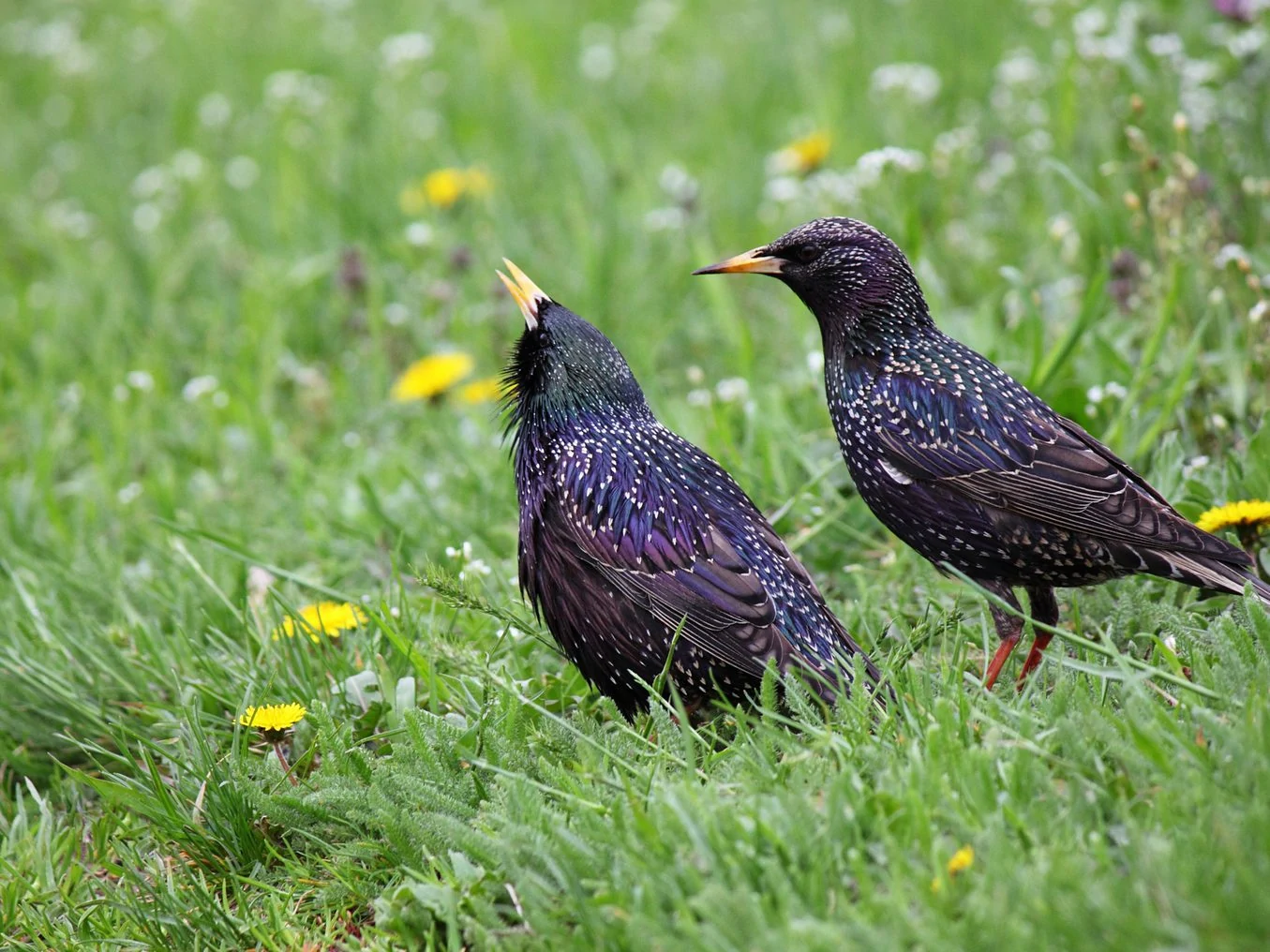
European Starlings are considered introduced species in Oklahoma that can be seen in the state all year.
They are the most frequently spotted blackbirds here and occur in 34% of checklists in summer and 29% of checklists in winter submitted by bird watchers for the state.
European Starlings are not native but are now one of the most numerous songbirds. They are stocky blackbirds with iridescent purple, green, and blue tones.
- Sturnus vulgaris
- Length: 7.9-9.1 in (20-23 cm)
- Weight: 2.1-3.4 oz (60-96 g)
- Wingspan: 12.2-15.8 in (31-40 cm)
European Starlings live in all North America, except the north of Canada and Alaska.
They are considered a pest due to their aggressive behavior, and they fly in large, noisy flocks. You can often spot them perched in groups on the top of trees or flying over fields.
Starlings eat insects, including beetles, flies and caterpillars, earthworms, and spiders. They will also eat fruit, including cherries, holly berries, mulberries, Virginia Creeper, sumac, and blackberries, as well as grains and seeds.
Starling sounds: Warbles, whistles, and chatter are all part of the starling’s calls and songs, and they can even mimic other birds’ calls. They are often in noisy groups.
Nests of Starlings are often in buildings or nest boxes and made out of grass, pine needles, and other soft material. They have 3 – 6 eggs and take 12 days to hatch. Fledging is around three weeks later.
You can attract more European Starlings to your backyard feeders with black oil sunflower seeds, suet, cracked corn, and peanuts.
Fun fact: European Starlings gather in their thousands in a swirling, dancing mass in the skies just before dusk. This is called a murmuration and usually happens in winter in their native areas.
2. Red-winged Blackbird
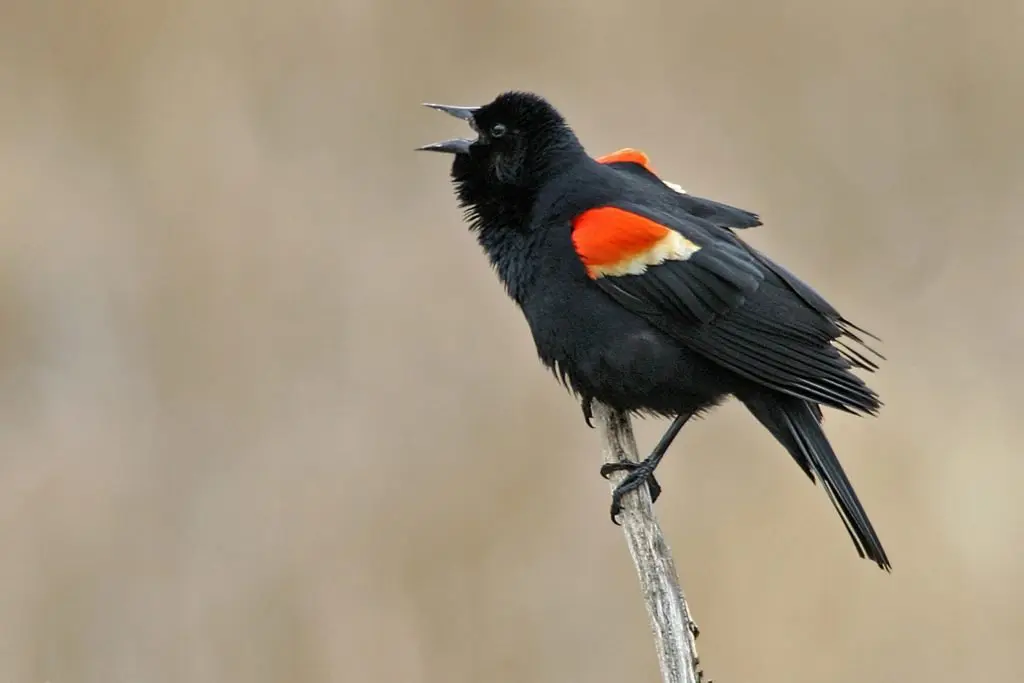
Red-winged blackbirds are the second most frequently spotted blackbirds in Oklahoma, and they do not migrate. They appear in 30% of checklists in summer and 20% of checklists in winter submitted by bird watchers for the state.
Red-winged blackbirds are very common and easy to identify with the all-black coloring except for the reddish-orange wing patches. Females are rather dull in comparison with streaky brown coloring.
- Agelaius phoeniceus
- Length: 6.7-9.1 in (17-23 cm)
- Weight: 1.1-2.7 oz (32-77 g)
- Wingspan: 12.2-15.8 in (31-40 cm)
Red-winged Blackbirds remain all year in the lower 48 and the Pacific Coast of British Columbia. Those that breed in Canada and some of the north of the lower 48 migrate south for the winter.
You can often spot Red-winged Blackbirds sitting on telephone wires. They prefer wet areas such as marshes but will nest in meadows and fields. Males will fiercely defend their territories in the breeding season, even attacking people that get too close to nests. In winter, they roost in large numbers into the millions.
Red-winged blackbirds eat mainly insects in summer and then seeds in the winter.
Red-winged Blackbird sounds: They make a short song that sounds like ‘Okelee’ and is drawn out at the end.
Nests of Red-winged Blackbirds are built near the ground in dense vegetation. The nest will be built by building a platform out of stalks and stems of nearby plants. This will have mud and wet leaves added to form a cup and then soft dry grass for the lining.
They lay 2 – 4 eggs, and the eggs take up to 13 days to hatch and then a further two weeks before the chicks can fledge.
Attract Red-winged blackbirds to your backyard with mixed grain and seeds spread on the ground. They will also feed on large tube feeders or platform feeders.
Fun fact: Male Red-winged Blackbirds will breed with up to 15 females and defend their territory from other males.
3. Brown-headed Cowbird
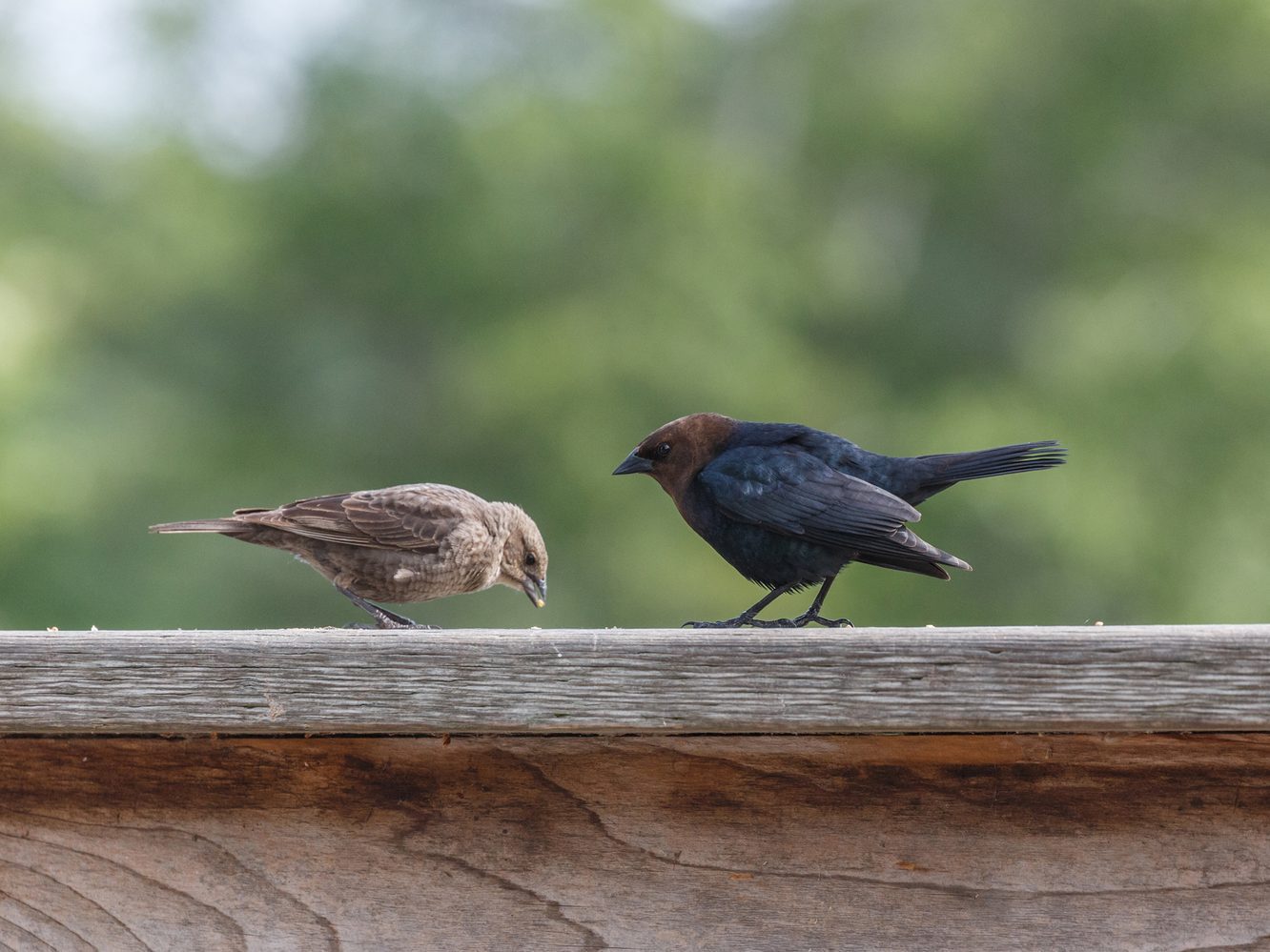
In summer, Brown-headed Cowbirds are the third most frequently spotted blackbirds in Oklahoma and appear in 28% of checklists.
They are more frequently spotted during summer, from February to August, but some are residents of the state all year. They also appear in 4% of winter checklists.
Male Brown-headed Cowbirds are black-bodied with brown heads and with short tails. Females are smaller and are gray-brown all over with slight streaking.
- Molothrus ater
- Length: 76.3-8.7 in (19-22 cm)
- Weight: 1.3-1.8 oz (42-50 g)
- Wingspan: 14.2 in (36 cm)
Brown-headed Cowbirds remain all year in eastern states, southern states, and along the Pacific Coast but those that breed in northern and western states and Canada migrate south for winter.
You can find Brown-headed Cowbirds in grasslands and fields but rarely in wooded areas. They forage on the ground, especially near grazing animals, waiting for them to kick up some food.
Grass and weed seeds make up most of their diet, but they also eat insects. They will also come to backyard feeders, and female cowbirds eat eggs and shells for calcium.
Brown-headed Cowbird Sounds: Their song has an almost water-like quality of a series of rapid, high-pitched whistles and gurgling sounds that only lasts a few seconds. They also make short calls.
Brown-headed Cowbirds do not build nests. They are often considered a nuisance as they destroy the eggs of smaller songbirds to lay their eggs in the nest and have the bird foster their chicks. They may also harass the host or destroy the nest if they remove their egg.
Fun fact: Are they brave or foolish? Brown-headed Cowbirds have also been known to lay their eggs in the nests of raptors!
4. Common Grackle
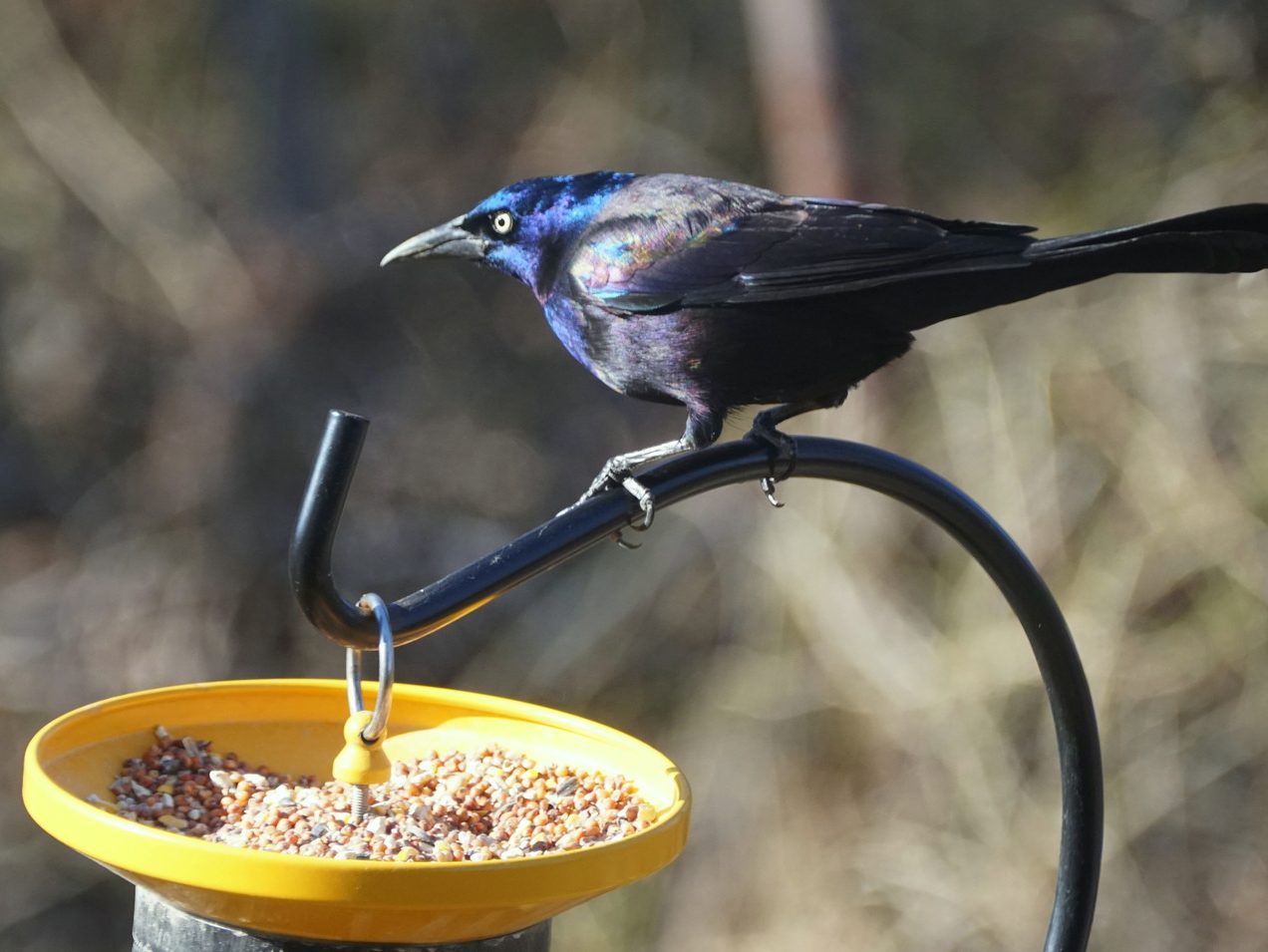
Common Grackles are considered near-threatened species in Oklahoma, but they are the fourth most frequently spotted blackbirds here.
Most of them migrate south for winter, but some do stay all year. They appear in 23% of checklists in summer and 5% of checklists in winter submitted by bird watchers for the state.
Common Grackles are blackbirds that are taller and longer tailed than a typical blackbird and with glossy iridescent bodies. Females are slightly less glossy than males.
- Quiscalus quiscula
- Length: 11.0-13.4 in (28-34 cm)
- Weight: 2.6-5.0 oz (74-142 g)
- Wingspan: 14.2-18.1 in (36-46 cm)
Common Grackles are resident all year in southeastern states, but those that breed in Canada and the Midwest migrate south.
Their habitat is varied and includes open woodlands, marshes, parks, and fields. They eat many crops but mostly corn and gather in noisy groups high up in trees. They will also eat garbage and so can be a nuisance.
Although they may gather in their millions, they are on the IUCN red list as near threatened due to the 50% decline in their numbers since the 1970s.
Common Grackle sounds: They make a series of croaks, squeaks, and whistles.
Nests of Common Grackles are made of twigs, leaves, and grasses are placed high up in conifer trees near water. They lay 1 – 7 eggs, which take about two weeks to hatch, and then the nestlings fledge in around another two weeks.
Attract Common Grackles to your backyard with mixed grain and seed sprinkled on the ground or on platform feeders.
Fun fact: Common Grackles may gather in their millions in winter to forage and roost, mixed in with other species of blackbird.
5. Eastern Meadowlark
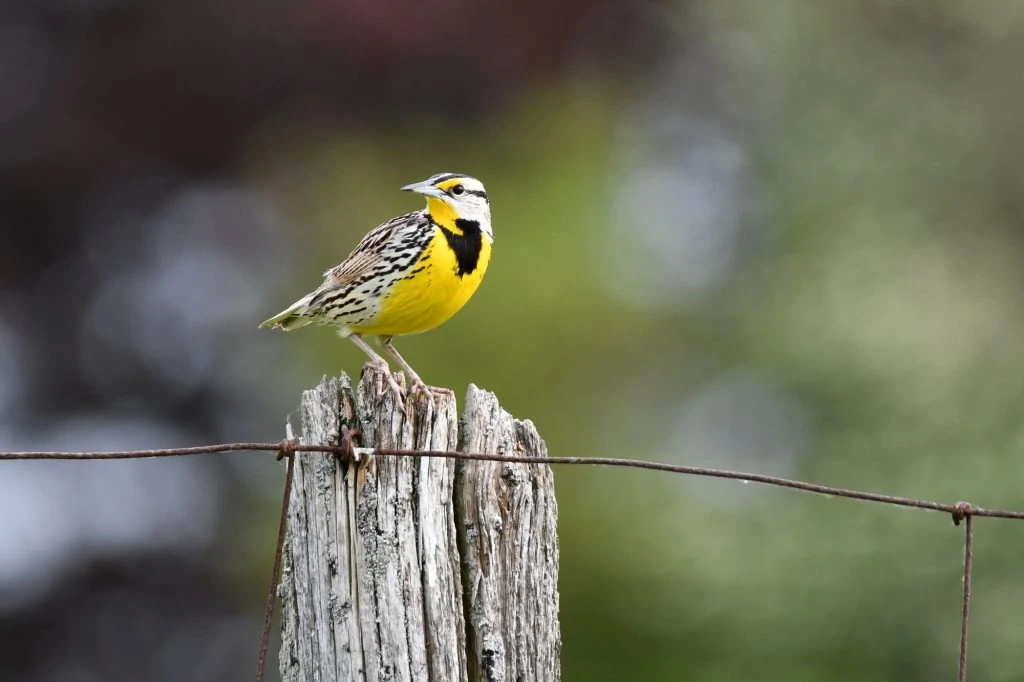
Although considered near-threatened species, Eastern Meadowlarks can be found in Oklahoma all year. They are recorded in 17% of summer checklists and 9% of winter checklists.
Eastern Meadowlarks are medium-sized songbirds that are bright yellow underneath and pale brown with black marks on the back. They have a distinctive black band across the chest.
- Sturnella magna
- Length: 7.5-10.2 in (19-26 cm)
- Weight: 3.2-5.3 oz (90-150 g)
- Wingspan: 13.8-15.8 in (35-40 cm)
Eastern Meadowlarks are found across eastern US states all year, but they will also breed in the Northeast and Canada before migrating south.
Spring in the East has arrived when the Eastern Meadowlark starts singing and putting on a display, but unfortunately, they are now classed as near-threatened.
They can be found on the ground in grasslands and prairies, eating insects. They gather in large flocks in fields in winter, looking for seeds.
Eastern Meadowlark sounds: They make flute-like whistles that are clear and melodious.
Nests of Eastern Meadowlarks are on the ground and can be pretty amazing constructions and include tunnels and roofs made of woven grasses.
Fun fact: Eastern Meadowlarks can sing more than 100 songs
6. Great-tailed Grackle
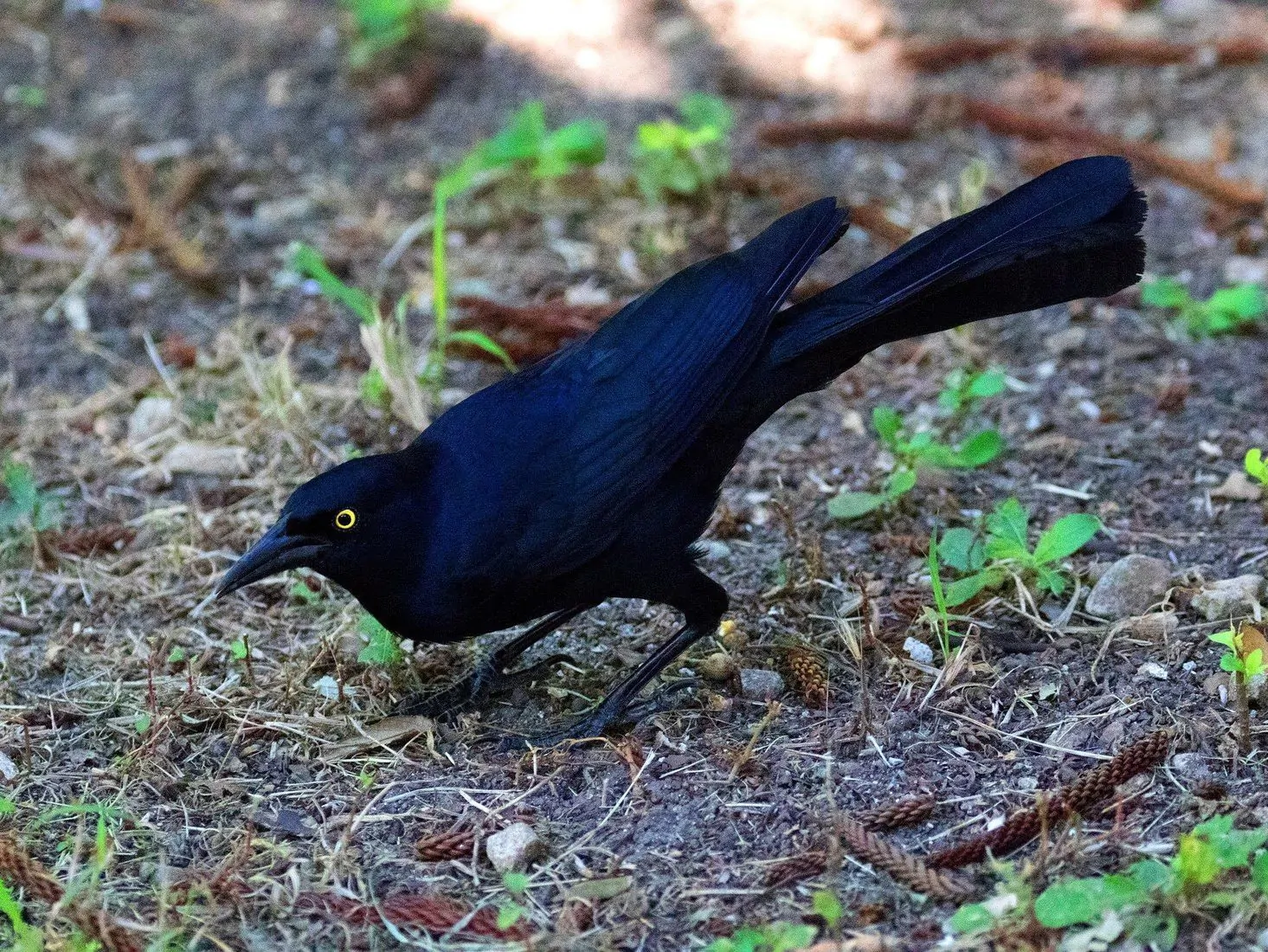
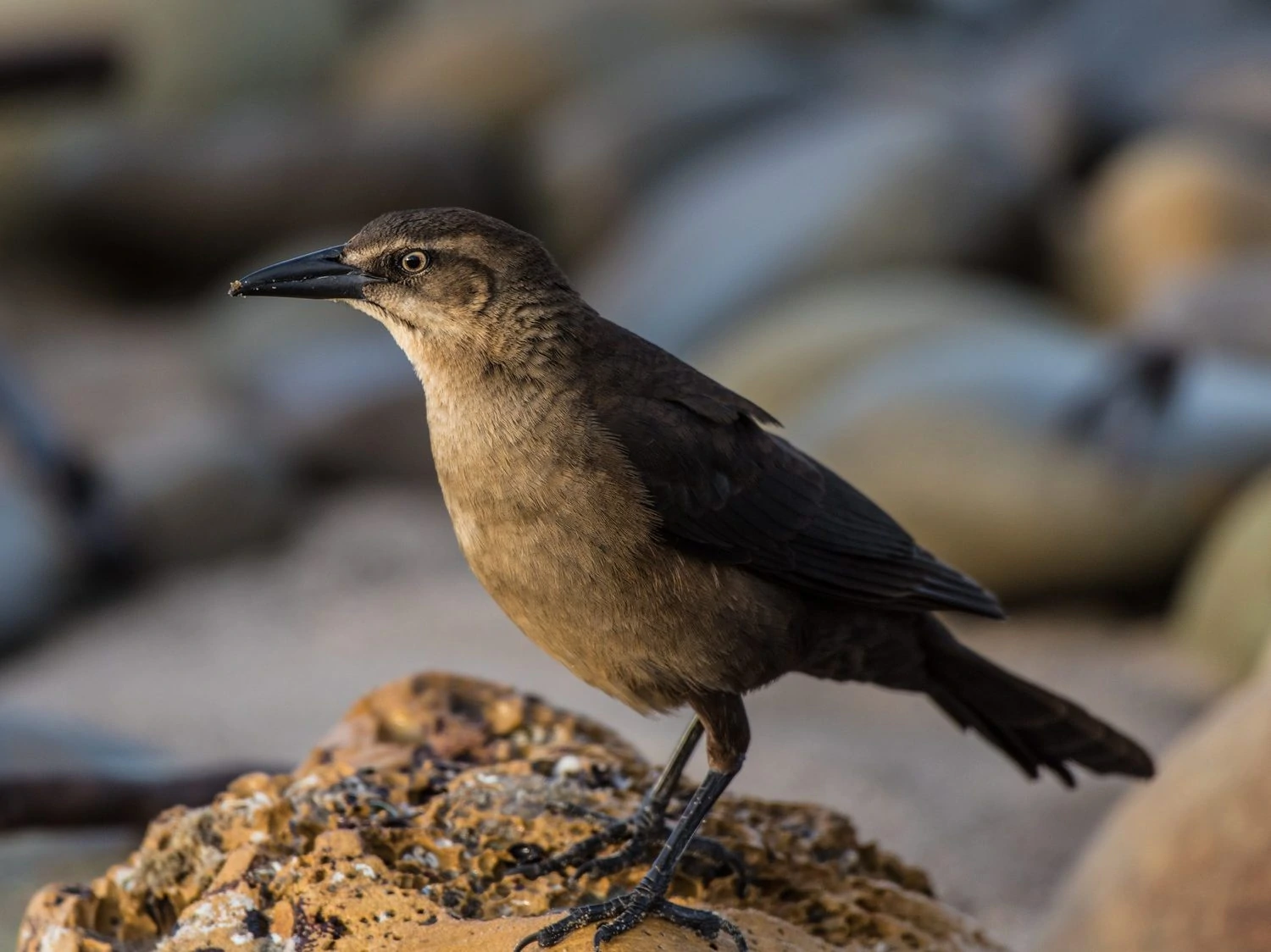
Great-tailed Grackles can be spotted all year in Oklahoma. They are recorded in 14% of summer checklists and 4% of winter checklists.
Great-tailed Grackles are long slender blackbirds with impressive long tapered tails in the males. Males are iridescent black with piercing yellow eyes. Females are also long-legged and slender but are dark brown on the back and lighter brown underneath, with more slender tails.
- Quiscalus mexicanus
- Length: 15.0-18.1 in (38-46 cm)
- Weight: 3.7-6.7 oz (105-190 g)
- Wingspan: 18.9-22.8 in (48-58 cm)
Great-tailed Grackles can be found in the West and Midwest in agricultural and urban areas, generally where humans are.
Great-tailed Grackles’ diet is grains, seeds, and fruit, as well as insects and other animals such as worms, beetles, spiders, bees, slugs, and snails. They will also sometimes eat small mammals and lizards as well as eggs and nestlings.
Great-tailed Grackle sounds: They have a fantastic array of whistles, shrieks, and rattles.
Nests of Great-tailed Grackles are usually high up in trees and made from grass, weeds, and twigs. First, mud lines the nest, followed by soft grass.
Great-tailed Grackles may be seen strutting across your lawn and can be attracted to seed dropping from feeders above. They will also eat black oil sunflower seeds, cracked corn, and millet on platform feeders or large hopper feeders.
Fun fact: Male Great-tailed Grackles are up to 60% heavier than females.
7. Baltimore Oriole
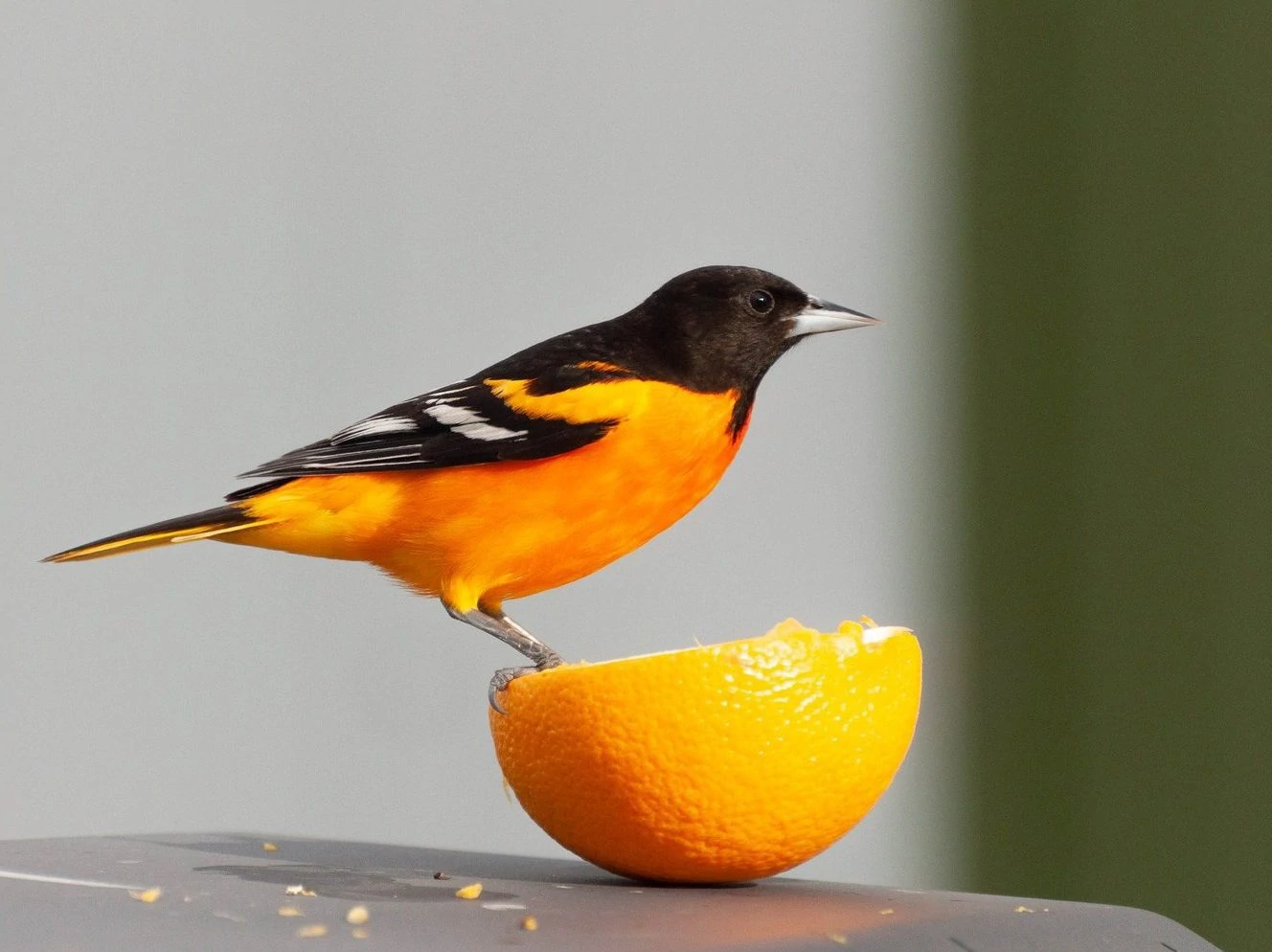
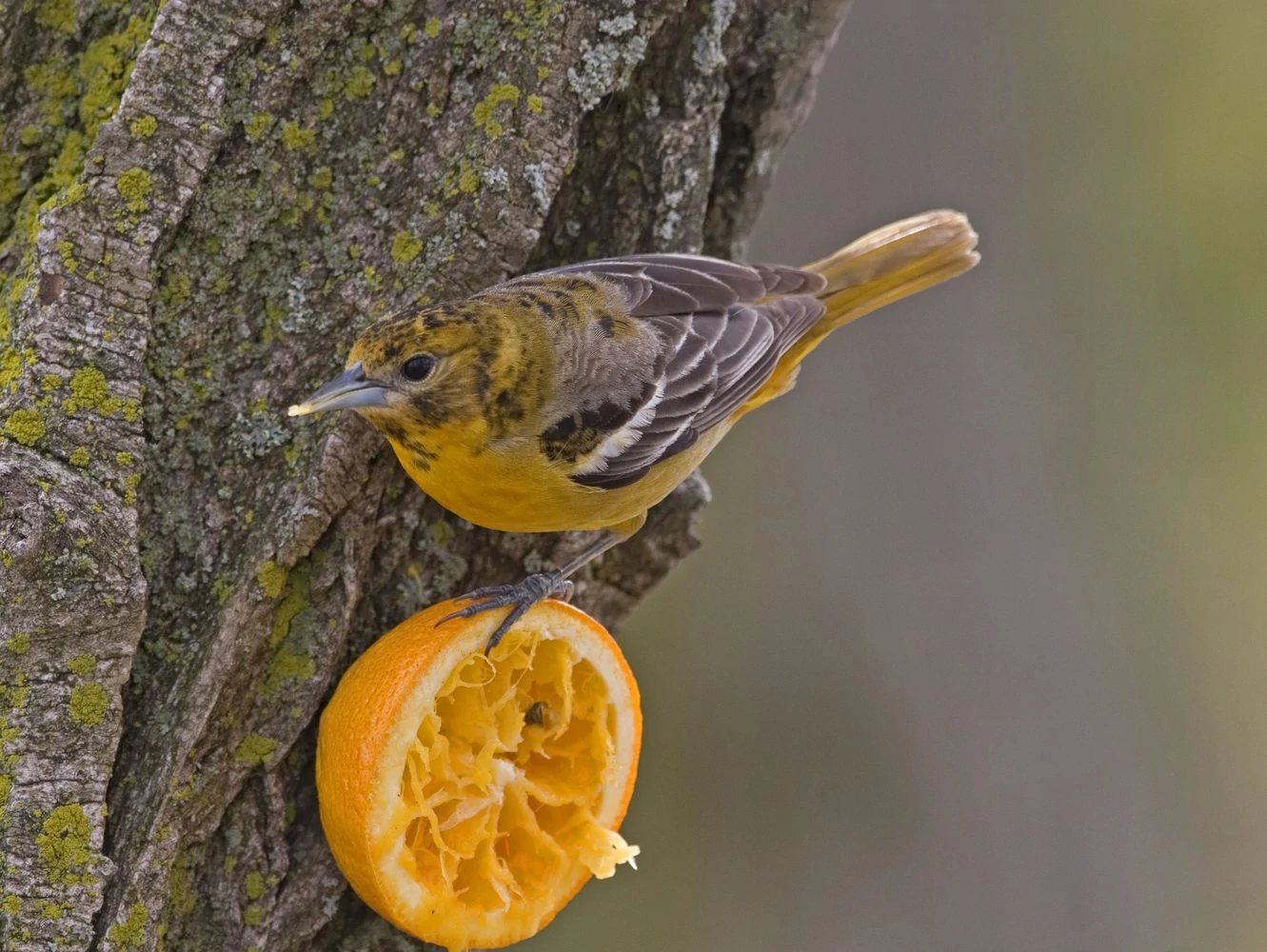
Baltimore Orioles are found in Oklahoma during the breeding season and appear in 13% of summer checklists. They are most likely to be spotted in the state from April to September, and then they fly south for the winter.
Baltimore Orioles are a colorful sign of spring in the east of North America. The adult males are bright orange and black with white wing bars on the black wings.
Females are yellowish underneath and on the head and grayish-brown on the wings, their backs or brownish-yellow. They are about the size of a Robin but more slender and are members of the blackbird family.
- Icterus galbula
- Length: 6.7-7.5 in (17-19 cm)
- Weight: 1.1-1.4 oz (30-40 g)
- Wingspan: 9.1-11.8 in (23-30 cm)
Baltimore Orioles breed in Eastern and Central States, including central-southern Canadian provinces and along the southern border with the US.
Baltimore Orioles then migrate to Florida, Central America, and the Caribbean for winter, leaving as early as July.
Baltimore Orioles can be found high up in open woodland, riverbanks, and forest edges foraging for insects and fruit, and they often come to parks and backyards.
Their diet is insects such as beetles, crickets, and grasshoppers, as well as spiders and snails. They also help eat pest species and eat a wide variety of fruits, and they can damage crops such as raspberries, mulberries, cherries, bananas, and oranges.
Baltimore Oriole sounds: The flute-like sound of Baltimore Orioles is one of the joys of spring. They also make chattering and sharp alarm calls.
Attract Baltimore Orioles to your backyard with oranges cut in half on a platform feeder or hanging them from trees. Also, try oriole feeders filled with sugar water. Planting some fruiting plants and nectar plants such as raspberries, crab apples, and trumpet vines should also attract them.
Fun fact: Baltimore Orioles make incredible hanging bag-like nests woven from fibers.
8. Western Meadowlark
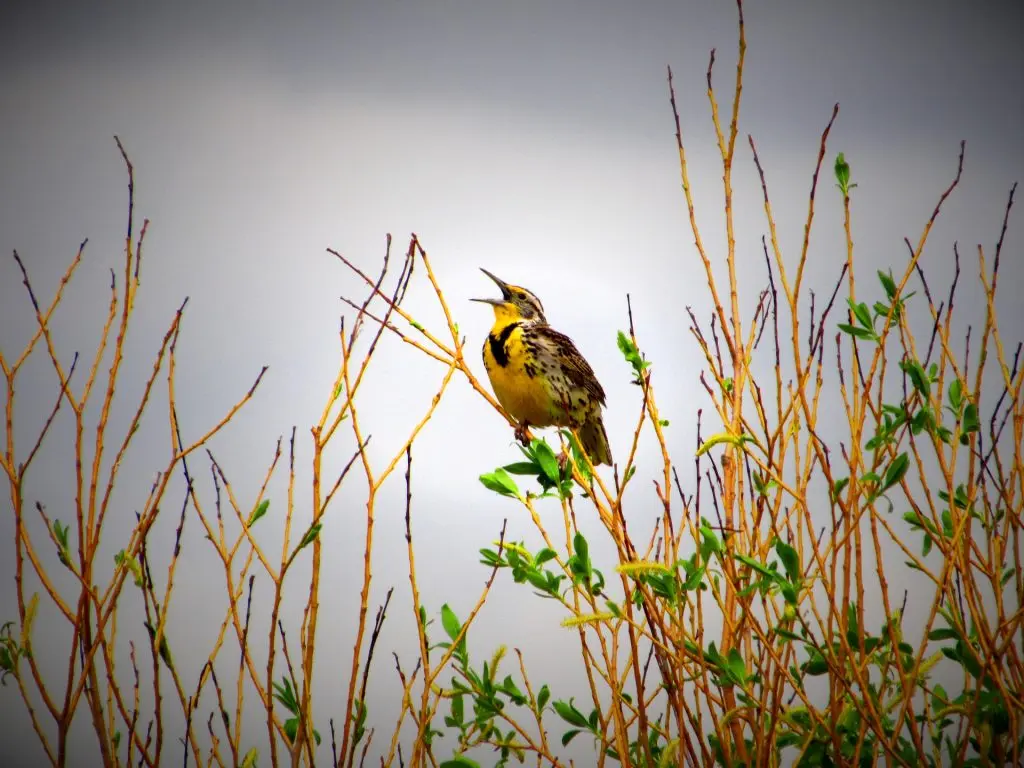
Western Meadowlarks are not very common in Oklahoma, but they can be spotted here all year. They appear in 3% of checklists in both summer and winter submitted by bird watchers for the state.
With their bright yellow bellies and melodious song, Western Meadowlarks can brighten up your day.
Western Meadowlarks are part of the blackbird family and are about the size of a Robin with shades of brown and white upperparts and a black V-shaped band across the bright yellow chest that turns gray in winter.
- Sturnella neglecta
- Length: 6.3-10.2 in (16-26 cm)
- Weight: 3.1-4.1 oz (89-115 g)
- Wingspan: 16.1 in (41 cm)
Western Meadowlarks that breed in northern US states and Canada migrate to more southern states in winter. However, those in the west and midwest remain all year.
You can find Western Meadowlarks usually on the ground in grasslands, meadows, and fields. They forage for food alone or in small flocks and are not usually found in woods or dense shrubby vegetation.
Western Meadowlarks’ diet consists of insects and seeds. They eat more insects n summer and more seeds and grain in winter.
Western Meadowlark sounds: They make a pleasant series of tweets, warbles, and whistles.
Check out the video below to hear the beautiful whistles and warbles of this songbird.
Nests of Western Meadowlarks are in depressions in the ground in grasslands. This is filled with soft material such as grass and may have a roof over the top, also made from grass and plant stalks.
Attract Western Meadowlarks to your backyard with sunflower seeds and cracked corn.
Fun fact: Western Meadowlarks have been chosen as the state bird for 6 US states.
9. Orchard Oriole
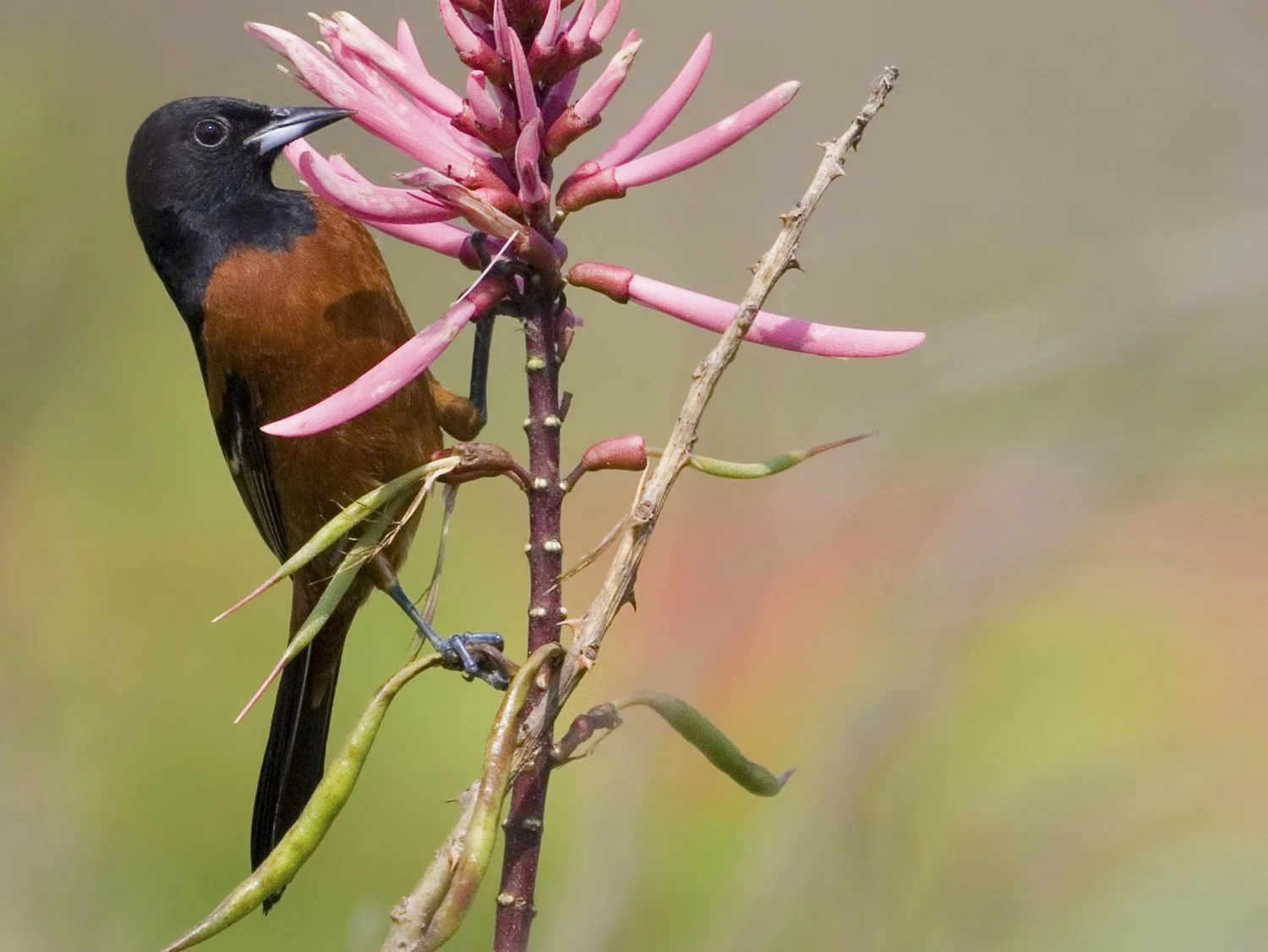
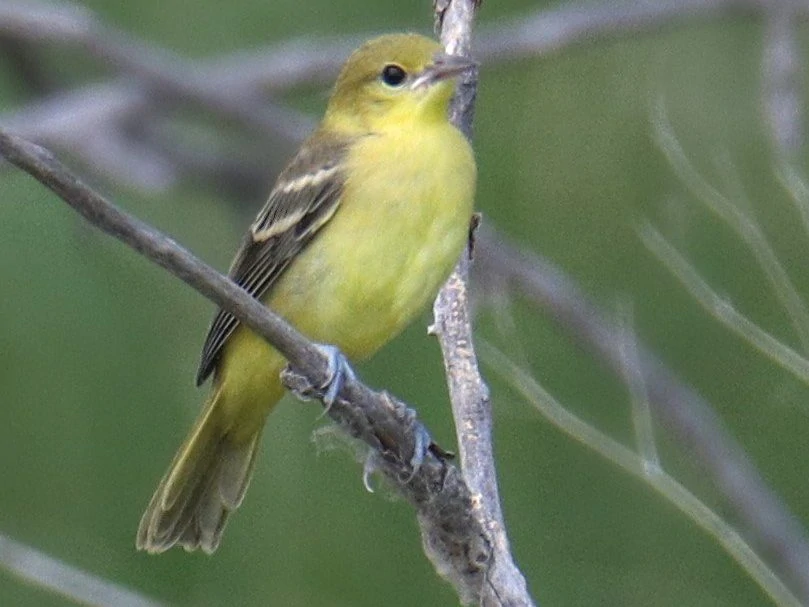
Orchard Orioles spend the breeding season in Oklahoma and appear in 8% of summer checklists. They can be seen in the state from April to September, and then they fly south for the winter.
Orchard Orioles females are greenish-yellow overall, paler underneath and darker on the back, with darker wings and white wingbars.
Males look very different with very bold coloring. They have black heads and backs and reddish undersides.
- Icterus spurius
- Length: 5.9-7.1 in (15-18 cm)
- Weight: 0.6-1.0 oz (16-28 g)
- Wingspan: 9.8 in (25 cm)
In summer, Orchard Orioles breed in the eastern half of the United States before migrating south to Mexico and Central America.
Preferring open woodland, Orchard Orioles can also be found along river banks and open shrubland and farms as well as backyards. They build hanging pouch-like nests.
Their diet is mostly insects such as ants, caterpillars, beetles, and grasshoppers, as well as spiders. They will also drink nectar from flowers and eat fruit such as mulberries and chokeberries.
Orchard Oriole sounds: They make a jumbled series of whistles that lasts about 3 to 4 seconds.
Nests of Orchard Orioles are a cup made from long grasses suspended from small branches of trees. They lay 4 – 6 eggs, which take about two weeks to hatch.
Attract Orchard Orioles to your yard with hummingbird feeders or platform feeders with cut oranges or mango. Also, plant native berry plants such as mulberries or chokeberries.
Fun fact: Orchard Orioles are the smallest species of blackbird in North America
10. Brewer’s Blackbird
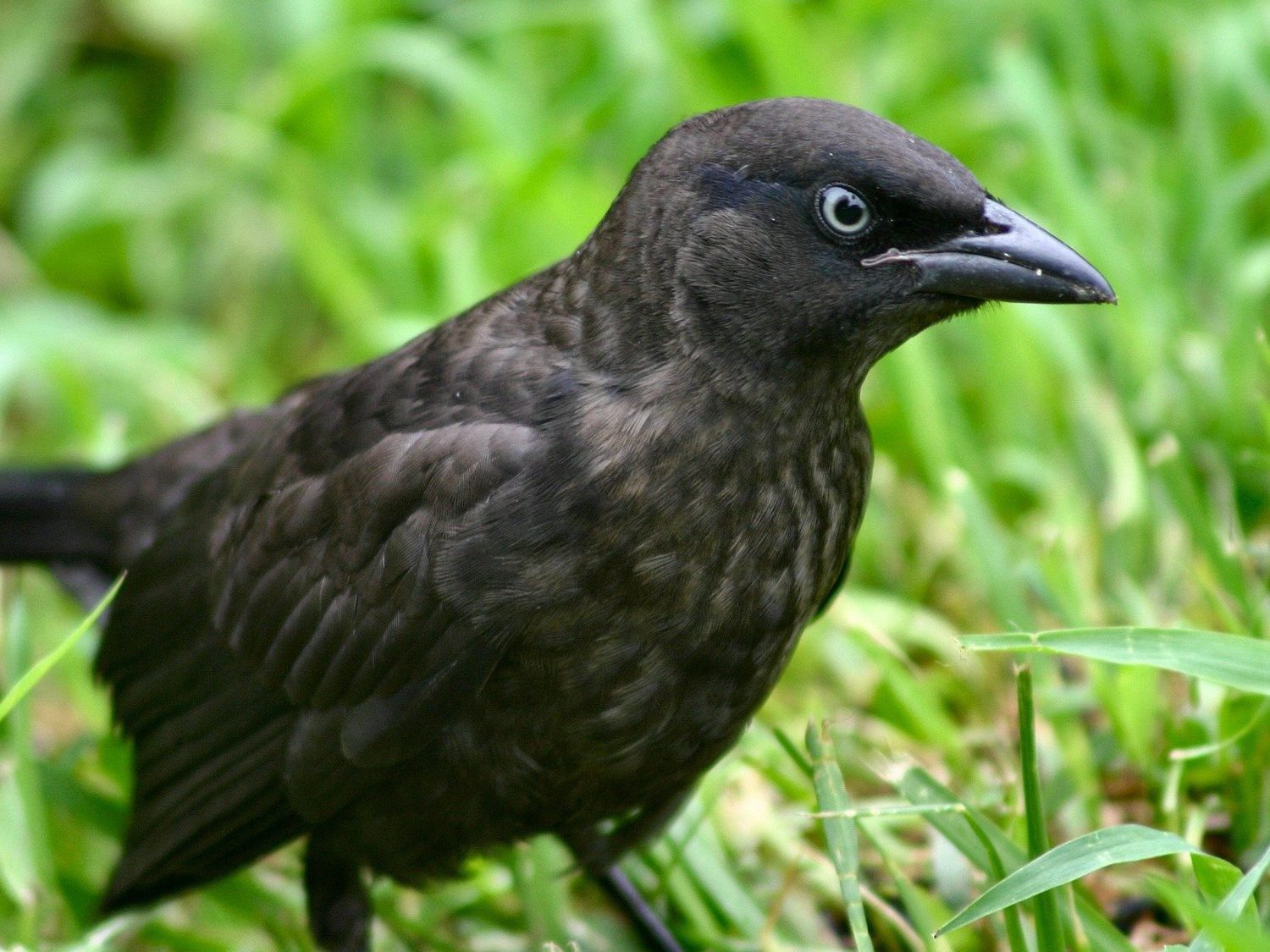
Brewer’s Blackbirds are recognized as regularly occurring in Oklahoma and can be seen here during winter. They can be seen in the state from September to mid-May and appear in 2% of winter checklists.
Brewer’s Blackbirds are medium-sized blackbirds with glossy black coats in the males with purple coloring on the head and greenish iridescent color on the body. Females are plain brown all over.
- Euphagus cyanocephalus
- Length: 7.9 -9.8 in (20-25 cm)
- Weight: 1.8 -3.0 oz (50-86 g)
- Wingspan: 14.6 in (37 cm)
Brewer’s Blackbirds can be found in all US states and southern Canada, except in the Northeast, and those in the west do not migrate.
However, those in more northern and central states and provinces migrate to the southern US and Mexico for winter. They can be seen during migration in eastern states.
Brewer’s blackbirds live in a wide variety of habitats, including grasslands, marshes, meadows, woodlands, and coasts, and near humans in parks, fields, and backyards. They eat mainly seeds and grain and insects or anything they can find.
Brewer’s Blackbird sounds: Brewer’s blackbirds make very short and shrill songs, and they also make ‘chuk’ calls.
Nests of Brewer’s Blackbirds are made from twigs and grass twisted together in shrubs or trees. First, the nest is lined with mud to hold it together, and then soft dry grass is used to line the cup.
Attract Brewer’s blackbirds to your backyard with seeds such as hulled sunflower seeds, cracked corn, and millet on ground feeders.
11.Yellow-headed Blackbird
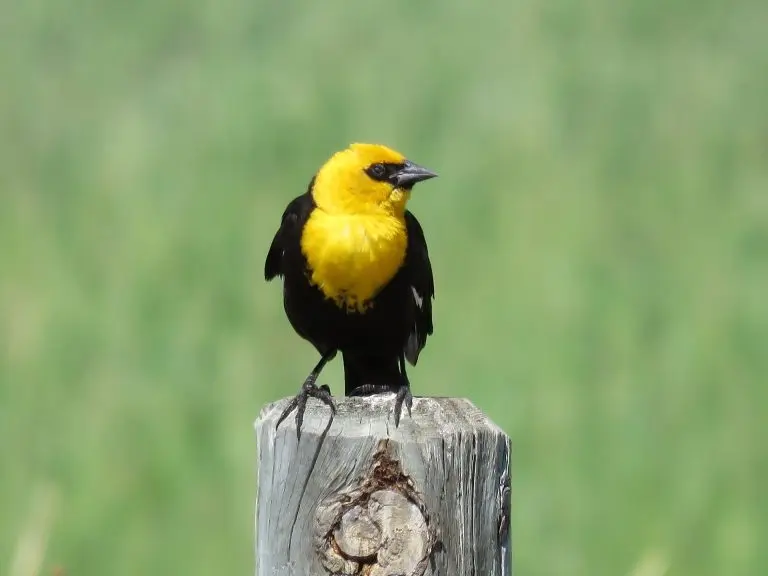
Yellow-headed Blackbirds are rarely spotted in Oklahoma, but they are recognized as regularly occurring in the state. They are most common during the spring migration in April to May and occur in 5.7% of checklists at this time.
Yellow-headed Blackbirds are striking birds with a glossy black bodies, bright yellow heads and chests, and white patches on the wings in males. Females are brown instead of black, and the yellow head is duller. They are larger than the Red-winged Blackbird.
- Xanthocephalus xanthocephalus
- Length: 8.3-10.2 in (21-26 cm)
- Weight: 1.6-3.5 oz (44-100 g)
- Wingspan: 16.5-17.3 in (42-44 cm)
Yellow-headed Blackbirds breed in western and prairie wetlands and nest in the reeds. They forage over surrounding wetlands, grasslands, and fields, mostly for insects in the summer.
After breeding, Yellow-headed Blackbirds migrate to fields and farmland in Southwest states and Mexico for the winter in large flocks.
Yellow-headed Blackbirds feed on insects in summer and seeds and grains in winter.
Yellow-headed Blackbirds sounds: The screeching buzz at the end of a few more musical notes is very distinctive.
Nests of Yellow-headed Blackbirds are made from long wet stems weaved together and attached to cattails or reeds over the water. They lay 2 – 5 eggs taking about two weeks to hatch and another week or two before fledging.
Attract Yellow-headed Blackbirds to your yard with sunflower seeds.
Fun fact: Yellow-headed Blackbirds hunt for insects by flipping over stones to flush them out.
12. Rusty Blackbird
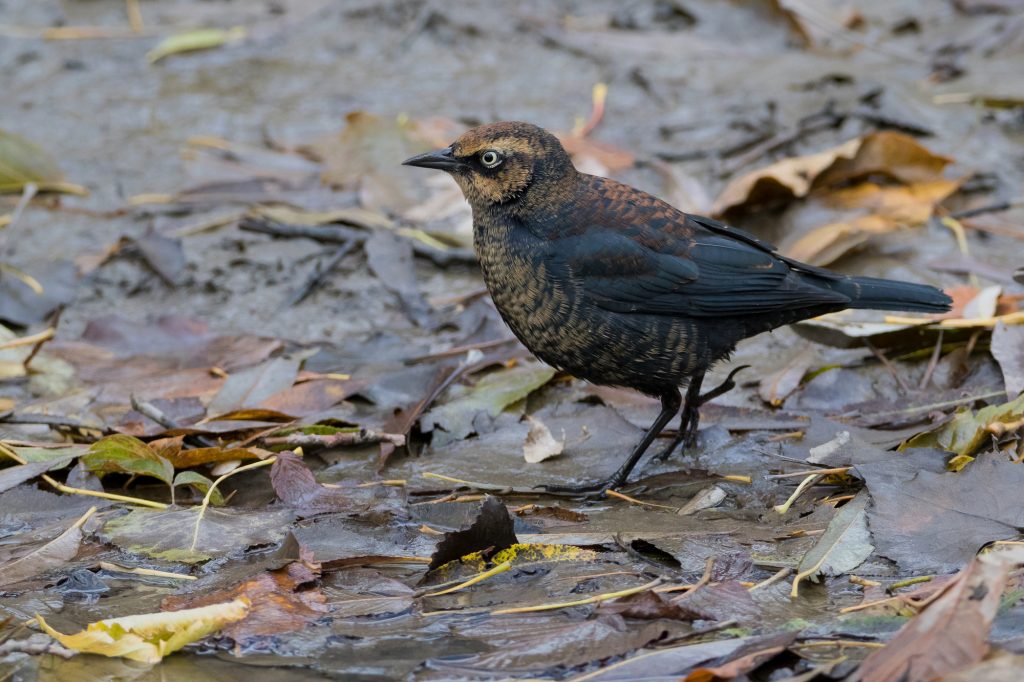
Rusty Blackbirds are considered vulnerable species, but they can be spotted in Oklahoma during winter. They are most likely to be seen from mid-October to April and are recorded in 1% of winter checklists.
Rusty Blackbirds males are dark glossy black in summer when in their breeding plumage and have a ‘rusty’ appearance in winter with rusty brown feather edges.
Females are grayish-brown and with the same rusty edges to the feathers. They also have a darker color around the eye and a lighter streak above.
- Euphagus carolinus
- Length: 8.3-9.8 in (21-25 cm)
- Weight: 1.7-2.8 oz (47-80 g)
- Wingspan: 14.6 in (37 cm)
Rusty Blackbirds breed in boreal forests in Canada before migrating to central and eastern US states.
You can find Rusty Blackbirds in wet areas such as swamps, marshes, bogs, and large ponds, but their population numbers have crashed by up to 99% in the past 40 years, and they are now on the ICUN red list as vulnerable.
They mainly eat insects, small fish, and seeds by flipping leaves and vegetation under the water. However, they have also been known to eat other birds.
Rusty Blackbird sounds: Two or three lower notes followed by a high-pitched whistle and creak.
Nests of Rusty Blackbirds are usually near water in trees and shrubs. They are made out of twigs and grass, and then wet rotting material is placed inside to harden and form the cup.
Fun fact: There is a Rusty Blackbird Working Group which is helping to monitor the massive decline in their numbers.
13. Bullock’s Oriole
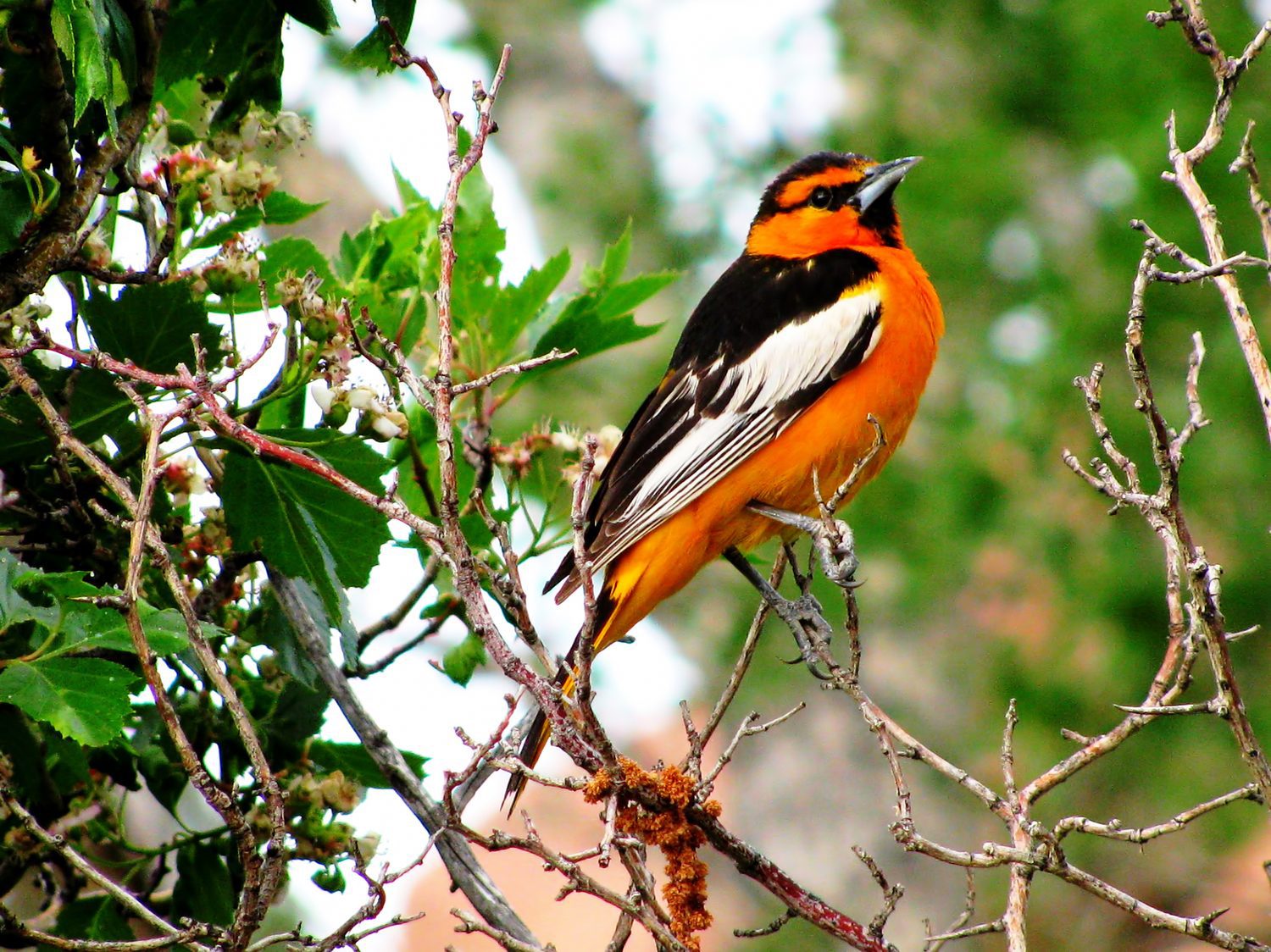
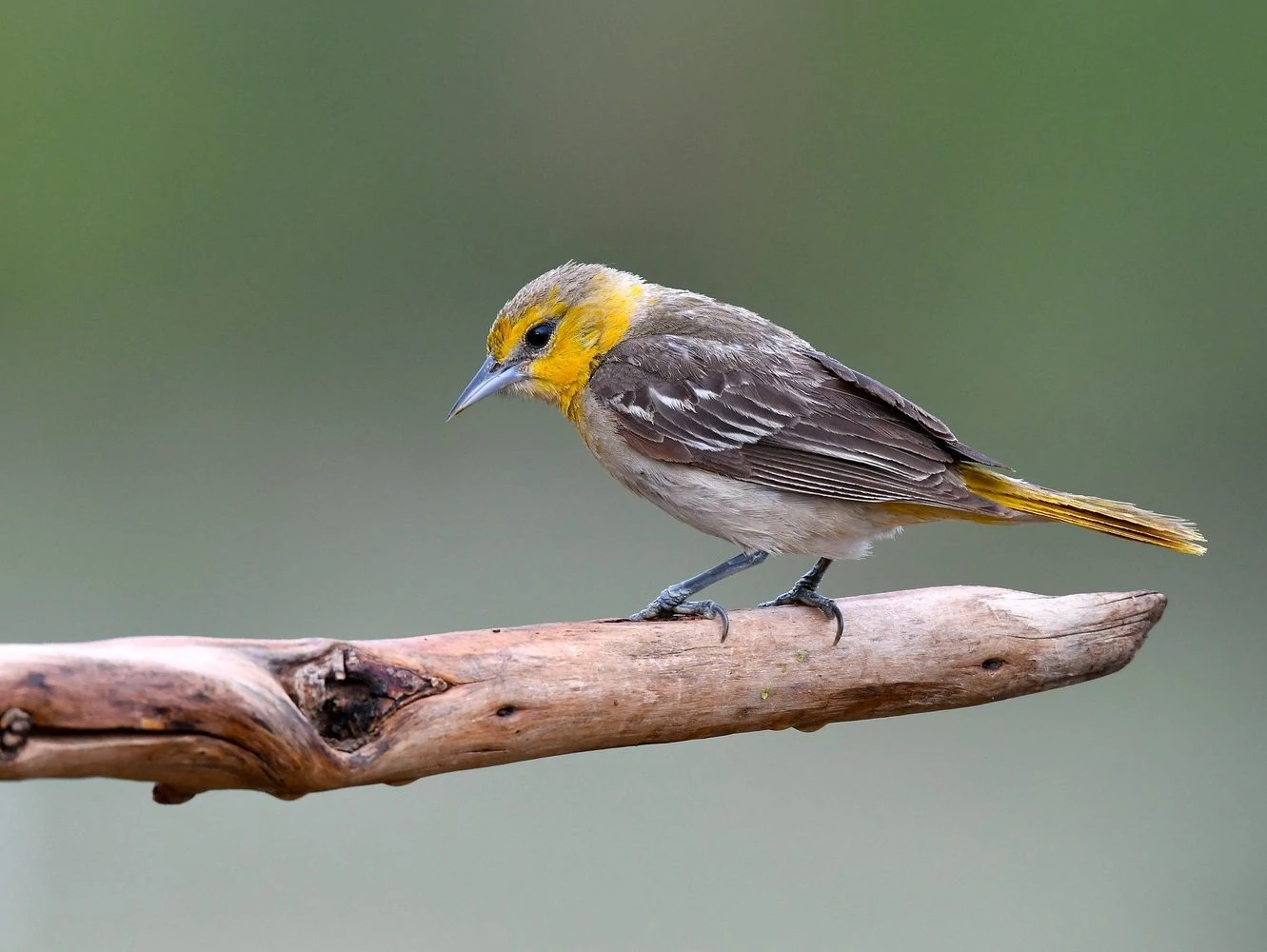
Bullock’s Orioles are rarely seen in Oklahoma, but they are recognized as regularly occurring in the state during the breeding season. They are mainly spotted in the west of the state from April to September.
Bullock’s Orioles males are bright orange with black and white wings and black markings on their heads.
Females and immature are duller with gray backs and yellow heads, tails, and chests.
- Icterus bullockii
- Length: 6.7-7.5 in (17-19 cm)
- Weight: 1.0-1.5 oz (29-43 g)
- Wingspan: 12.2 in (31 cm)
Bullock’s Orioles breed in the western half of the US and spend the winter in Mexico.
You can find Bullock’s Orioles in open woodlands and parks foraging for insects, fruit, and nectar.
Bullock’s Oriole sounds: They make a series of cheeps and whistles that last a few seconds.
Attract Bullock’s Orioles to your backyard with sugar water, jelly and fruit.
Fun fact: Their nests are woven from hair, grass, and wool into a gourd shape and take up to 15 days to complete.
14. Bobolink
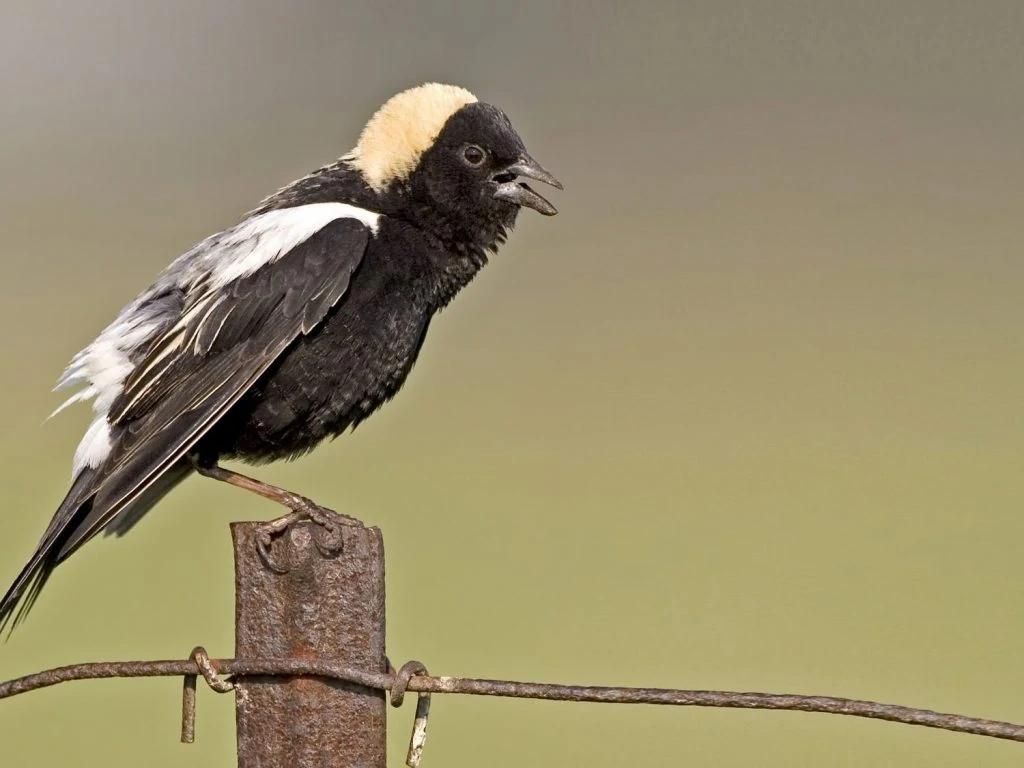
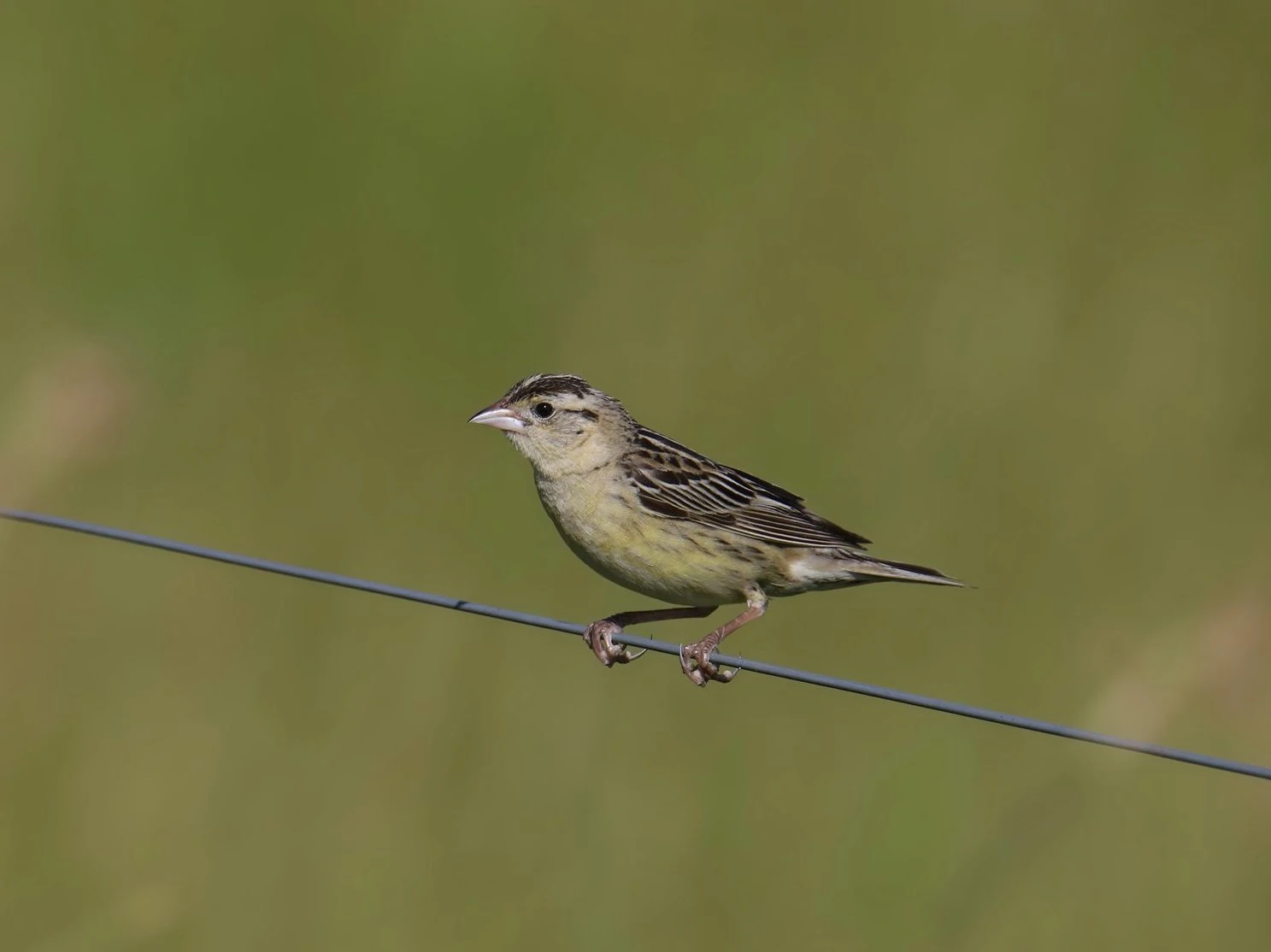
Bobolinks are only spotted during the spring and fall migration in Oklahoma. They can be spotted from late April to May and again from October to early November.
They are most likely to be spotted in May here and occur in 2.7% of checklists at this time.
Breeding Bobolink males are easy to identify as they are very unusual-looking birds, with white backs, black bellies, and a striking pale yellow patch at the back of their heads that looks like hair!
Females and non-breeding males in their winter plumage are quite different and rather plain in comparison. They are brown-streaked and with dark eyelines and stripes on their crowns.
- Dolichonyx oryzivorus
- Length: 5.9-8.3 in (15-21 cm)
- Weight: 1.0-2.0 oz (29-56 g)
- Wingspan: 10.6 in (27 cm)
Bobolinks travel far from their wintering grounds in inland southern South America to their breeding grounds in northern US states and Canada, a journey of over 12,000 miles (20,000 kilometers). During migration, they can be spotted in eastern US states.
To find Bobolinks head to open grassland during the breeding season, and after breeding, they can be found in marshes and coastal areas.
They can often be spotted perched at the top plants looking for seeds and or on the ground looking for insects to feed their young.
Bobolink Sounds: Boblinks songs are a speedy mix of different pitches and tones that do not seem to follow a pattern. They also make several short ‘peek’ and ‘check’ calls.
Unfortunately, Bobolinks have declined by 65% since 1966, although the breeding population is 8 million, this is significantly less than it used to be. You can help by only mowing once a year after they have left your grassy fields and meadows.
Fun fact: Bobolink nests are on the ground, and the males make splendid displays of singing, flying, and fighting to attract females.
15. Bronzed Cowbird
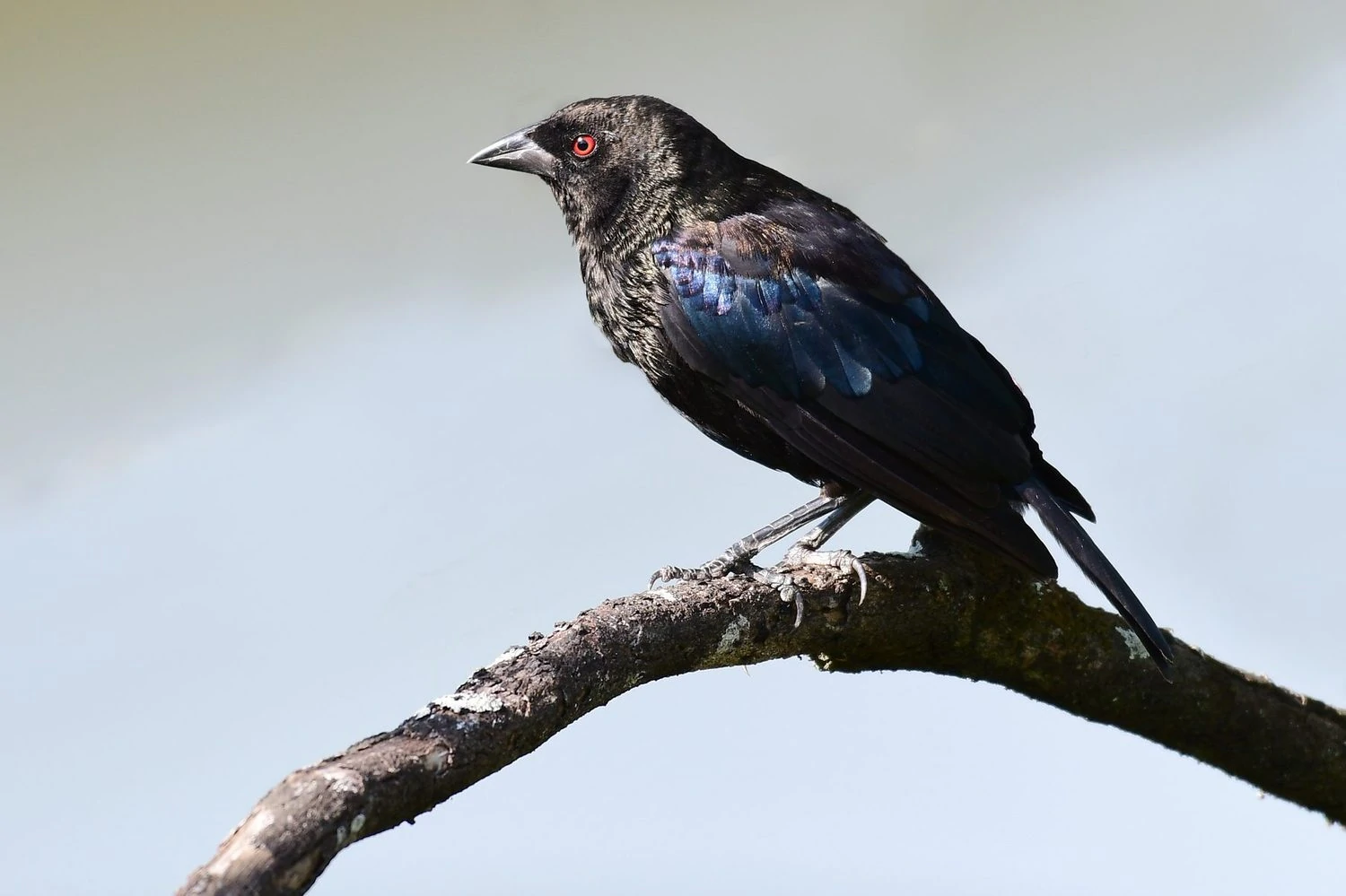
Bronzed Cowbirds are considered accidental species in Oklahoma, and they were only spotted in Kenton in 2020.
Bronzed Cowbirds are bigger and more stocky than other cowbirds, and the males have red eyes that stand out against their black color. Their wings are dark glossy blue.
Females are brown in the west of their range but darker in the east. They also have red eyes, but juveniles have black eyes.
- Molothrus aeneus
- Length: 7.9 in (20 cm)
- Weight: 2.3-2.6 oz (64.9-73.9 g)
- Wingspan: 13.0 in (33 cm)
Bronzed Cowbirds are only found in southern US states from California to Florida, mainly during summer for the breeding season.
Look for Bronzed Cowbirds walking on the ground in open fields and pastures in the east and also in more wooded areas in the west of their range. They will also come to backyard feeders and will eat seeds, grains, and insects.
Bronzed Cowbirds sounds: Harsh jeeps form their song, and they also scream and make chattering calls.
Bronzed Cowbirds do not build nests as they lay their eggs in the nests of other species.
Fun Fact: Bronzed Cowbirds males ruff up their nape feathers and hold open their wings in a dramatic mating display. They lay their eggs in the nest of other species and do not build nests or look after their young.
16. Scott’s Oriole
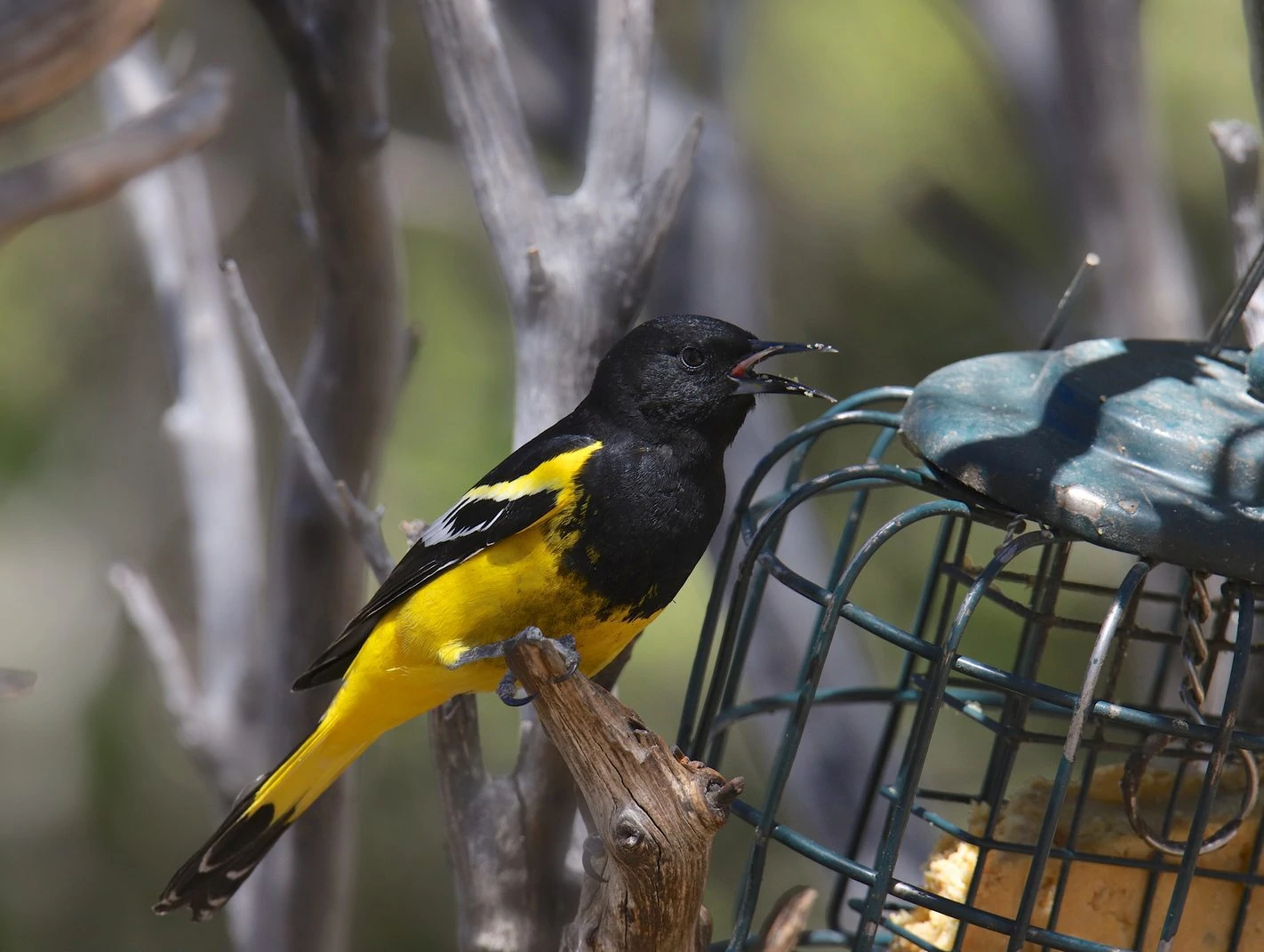
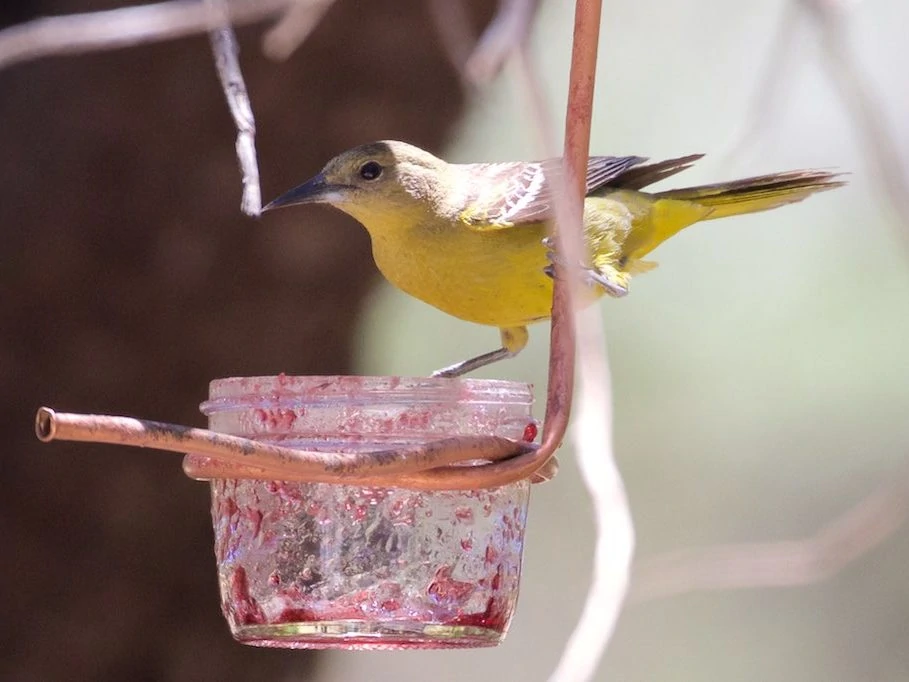
Scott’s Orioles are considered an accidental species in Oklahoma, and according to records, they were last spotted in Black Mesa State Park back in 2018.
A large distinctive oriole with a bright yellow underside and black head and back in the males. Females are a paler yellow with olive-brown backs.
- Icterus parisorum
- Length: 9.1 in (23 cm)
- Weight: 1.1-1.4 oz (32-41 g)
- Wingspan: 12.6 in (32 cm)
Scott’s Orioles breed in southwestern US states and northern Mexico before migrating south for winter. They also remain all year in southern Mexico and Baja California.
You can find Scott’s Orioles on higher slopes in arid areas feeding on insects, nectar, and fruit. They are often found on yuccas and begin singing before dawn.
Scott’s Oriole sounds: Their song is a sweet series of whistles and is less jumbled than some orioles songs.
Nests are often quite low down at only 5 – 7 feet and are a basket of cactus fibers, grass, and yucca leaf. They may have 2 or 3 broods in a year.
Attract Scott’s Orioles to your backyard with sugar water, jelly, and oranges.
Fun fact: Scott’s Orioles will feed on toxic monarch butterflies by finding the ones with the least toxins and eating those.
17. Shiny Cowbird
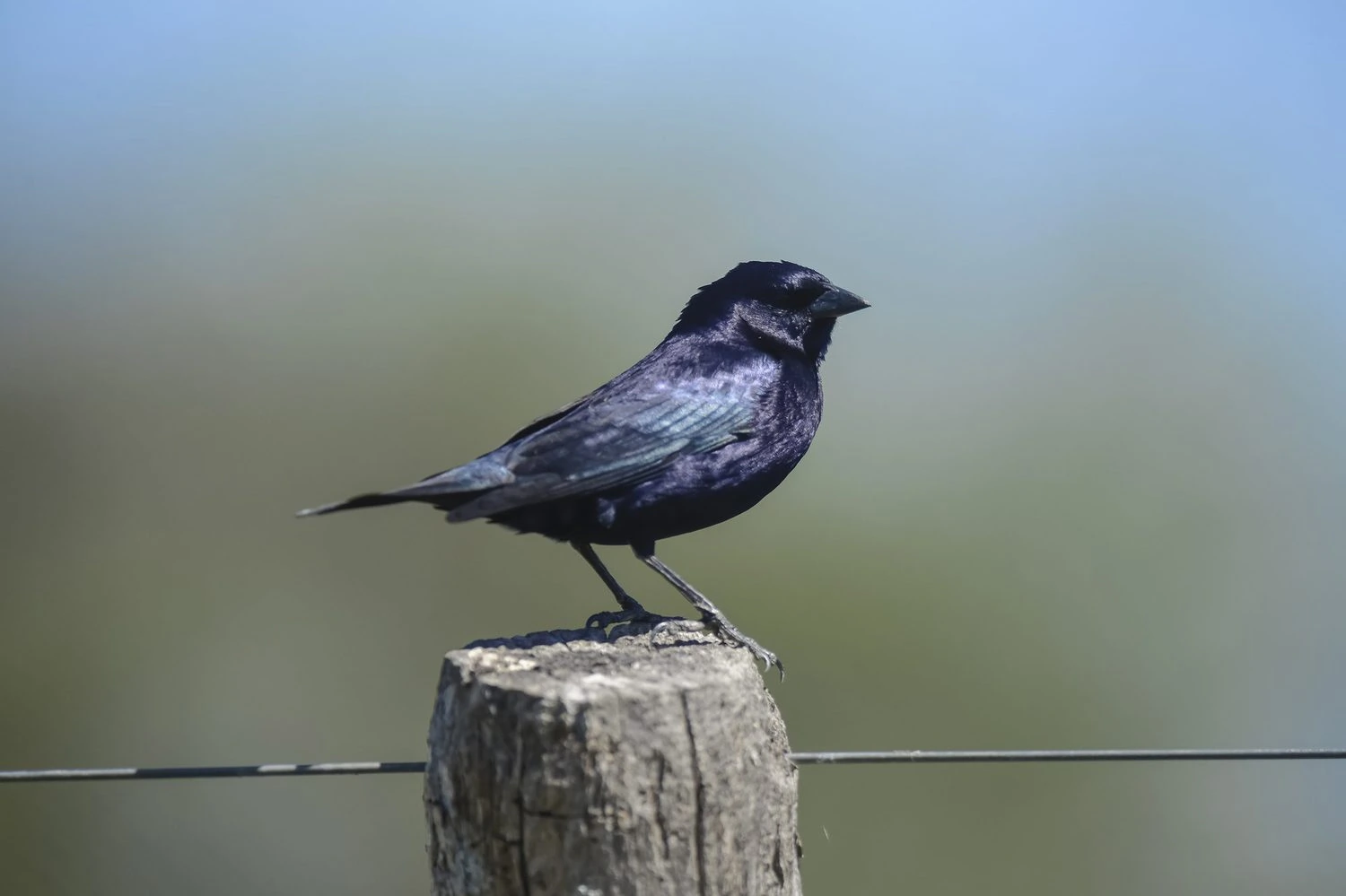
Shiny Cowbirds are extremely rare in Oklahoma, and they are considered accidental species here. In fact, they have only been spotted in the state way back in 1990.
Shiny Cowbirds males are glossy dark velvety purple all over, but from a distance, they can look black. Females are brown and look similar to female Brown-headed cowbirds.
- Molothrus bonariensis
- Length: 7.1 in (18 cm)
- Weight: 1.1-1.4 oz (31-40 g)
Shiny Cowbirds are mainly found in South America, southern Central America, and the Caribbean, but they also live in Florida and along the southern coast of the US.
They feed on insects, seeds, and grains from the ground in open areas. They will also hunt for insects in trees and will visit backyard feeders.
Shiny Cowbirds sounds: Low guttural croaks and high-pitched squeaks.
Shiny Cowbirds, like most cowbirds, do not build nests and instead lay their eggs in the nests of other species.
Fun fact: Shiny Cowbirds will lay their eggs before the host lays so that their chicks are born first and grow stronger before the host chick and become the only survivor.
How to Attract Blackbirds to Your Backyard
Blackbirds can easily be attracted to your backyard by making a few simple changes:
- Provide fruiting and berries plants such as blackberries, raspberries, cherries and plums
- Provide a fresh water source
- Hand nectar feeders for orioles
- Hang feeders for blackbirds containing cracked corn, millet and peanuts
- Do not tidy too much! By leaving beds a little messy this provides a great habitat for insects for blackbirds to eat.

